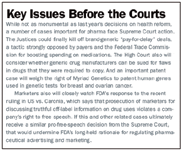Transformation to Characterize 2013
Pharmaceutical Executive
FDA policies will reshape drug development, while pressure to cut healthcare spending may alter drug coverage and pricing.
In recent months, the presidential election confirmed the status quo in the White House and on Capitol Hill, the Supreme Court retained health reform, and Congress reauthorized user fees and important new authorities for the Food and Drug Administration. So one might expect 2013 to be less strenuous for the biopharmaceutical community. But as the Obama administration tackles the monumental task of implementing new health programs authorized by the Affordable Care Act, pharma faces the daunting assignment of making sure that these policies broaden patient access to prescription drugs without imposing price controls.

Jill Wechsler
Moreover, pressure to fill depleted new drug pipelines, challenges in dealing with a diverse global pharmaceutical supply chain, and opposition to high drug prices will keep pharmaceutical executives fully engaged in the coming months. Add to the mix the legal debate over the constitutionality of FDA curbs on off-label communications (see sidebar), continuing shortages of critical drugs, and alarms over deaths from questionable drug compounding activities, and the road ahead looks pretty rocky. It's not clear whether FDA commissioner Margaret Hamburg will remain on the job for just one more year or longer, creating uncertainty about the agency's future directions.

Key Issues Before the Courts
Casting a cloud on all these situations is the imperative to reduce the federal deficit by spending less and collecting more taxes. Pharma companies have a stake in corporate tax reform efforts related to foreign-source income, as well as tax incentives for R&D. Federal budget cuts threaten Medicare and Medicaid payments for drugs and adequate funding for FDA, the National Institutes of Health, and other programs involved in biomedical research and pharmaceutical utilization.
New focus at FDA
This is a "transformational time" in the nation's healthcare system, raising expectations about medical product effectiveness and demands for more effective oversight despite limited resources. FDA is responding by working overtime to implement the multiple requirements of the FDA Safety & Innovation Act (FDASIA), reported Douglas Throckmorton, deputy director of the Center for Drug Evaluation and Research (CDER), at the FDA/CMS Summit sponsored by Elsevier Business Intelligence. There are new user fees for generic drugs designed to speed up approvals and ensure timely plant inspections. A clear pathway for approving new biosimilars is emerging, spurring several INDs, but so far no product applications.
A main focus of FDASIA is to encourage development of new antibiotics, orphan drugs, and "breakthrough" therapies for critical diseases. CDER is drafting guidance on its expedited approval pathways—fast track, breakthrough, priority review, and accelerated approval—to clarify the opportunities and requirements created by these options, noted CDER Office of New Drugs (OND) director John Jenkins. He pointed to the rise in commercial INDs in recent months as a factor boosting FDA approvals of new molecular entities for 2012, including several breakthrough therapies. OND's more transparent and managed review process aims to meet user fee goals and achieve more first review cycle approvals, particularly for priority applications. And liaison staffers at CDER will offer assistance to firms navigating the FDA review system, which should be particularly helpful for the growing number of "emerging sponsors" filing their first new drug applications.
CDER will continue to address postmarketing safety issues, as seen in its expanding Sentinel and mini-Sentinel systems that provide rapid access to patient data to answer questions about drug adverse events. The agency is fine-tuning its REMS (risk evaluation and mitigation strategies) program, responding to demands from providers for integration of REMS into healthcare systems and pharmacy operations. A number of high-profile public health issues, namely drug shortages, opioid abuse, and drug compounding, are top concerns for FDA, and FDASIA provides added authority to require early notification of looming shortages and to halt violative drug imports and counterfeits.
To better handle these changes CDER director Janet Woodcock recently made the Office of Generic Drugs an independent "super" office. A new Office of Pharmaceutical Quality (OPQ) will tackle drug manufacturing quality issues and supply chain challenges and better coordinate field plant inspections. More details on CDER reorganization should emerge over the next six months.
Costs and coverage
As deficit reduction talks continue, pharmaceutical companies are steeling themselves for a wave of proposals to cut healthcare expenditures by reducing reimbursement for providers and slowing spending on prescription drugs. Three years ago, industry supported health reform and its promise to extend coverage to millions of individuals through insurance exchanges and expanded Medicaid programs. Manufacturers agreed to pay billions in fees, higher Medicaid rebates and part of the cost of closing the Part D coverage gap in return for expanded drug access and a market-based Medicare drug program.
Now pharma faces policies that would tighten utilization controls on high-cost specialty drugs and demand more fees and rebates. The White House has proposed to reduce exclusivity on brand name biologics from 12 to seven years, rejecting the timeframe negotiated for the biosimilar program. And the administration backs a prohibition on pay-for-delay generic-brand deals as another way to save money. There's enthusiasm for comparative effectiveness research, moreover, to direct coverage to more effective and less costly treatments.
A top priority for pharma thus is to head off added rebates on Part D plans, specifically on the drugs used by "dual eligible" seniors who qualify for both Medicaid and Medicare benefits. Drug marketers did as well as they could have expected when HHS ruled in November that health plans marketed through exchanges should provide coverage for more than one drug per class to meet "essential health benefit" (EHB) requirements. In fact, most states will adopt "benchmark" plans that cover many more drugs, especially those with open formularies that list more than 1,000 medicines.
But it's unlikely that pharma can squash a Medicare rebate completely in this budget-cutting climate where added fees on drug companies look pretty attractive to alternative cost-cutting actions, such as raising the Medicare eligibility age or limiting Medicaid coverage. If pharma doesn't want to get hit by a $100 billion bill for new rebates and other fees, industry will need to bring alternative proposals to the table in the coming months.
Jill Wechsler is Pharmaceutical Executive's Washington correspondent. She can be reached at jwechsler@advanstar.com

Navigating Distrust: Pharma in the Age of Social Media
February 18th 2025Ian Baer, Founder and CEO of Sooth, discusses how the growing distrust in social media will impact industry marketing strategies and the relationships between pharmaceutical companies and the patients they aim to serve. He also explains dark social, how to combat misinformation, closing the trust gap, and more.
FDA Grants Priority Review to Regeneron’s Eylea for Macular Edema Following Retinal Vein Occlusion
April 18th 2025Regulatory action was based on data from the Phase III QUASAR trial, which demonstrated that Eylea HD dosed every eight weeks achieved non-inferior visual acuity outcomes compared to Eylea in patients with macular edema following retinal vein occlusion.